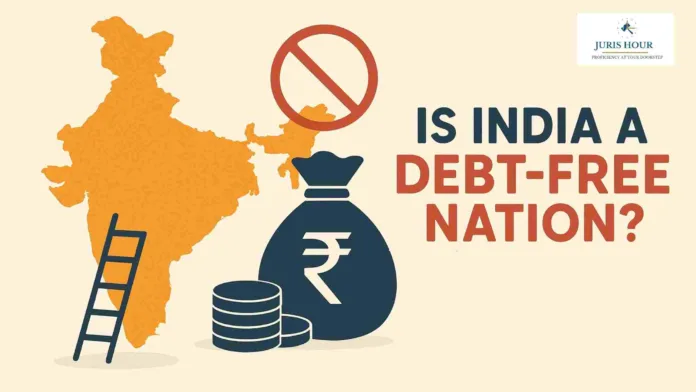No, India is not debt-free. As of March 2025, India’s total public debt stands at approximately ₹185.11 lakh crore (₹18.51 trillion), representing around 80.6% of its Gross Domestic Product (GDP). This public debt is composed of both internal and external borrowings, reflecting the government’s fiscal strategy over decades.
What Constitutes India’s Public Debt?
India’s public debt consists of two major components:
- Internal (Domestic) Debt: This includes government securities, treasury bills, and other borrowings raised from within India. Currently, internal debt accounts for nearly 96.59% of India’s total public debt.
- External Debt: This refers to loans and borrowings from foreign governments, international financial institutions, and global capital markets. At the end of FY25, India’s external debt rose to $736.3 billion, marking a 10% increase over the previous year, and representing approximately 19.1% of GDP.
Why Is India Not a Debt-Free Nation? Key Reasons Explained
1. Developmental Expenditure and Infrastructure Investment
India, as a developing economy, has significant capital-intensive projects essential for accelerating growth. Building infrastructure such as highways, railways, power plants, urban transit systems, and telecommunications networks requires large amounts of capital investment. These projects often span several years and require substantial upfront funding, far exceeding immediate government revenues. As a result, the government relies on borrowing to finance these critical investments aimed at long-term economic growth.
2. Social Welfare Schemes
India has one of the largest social welfare frameworks in the world, encompassing programs such as:
- Mahatma Gandhi National Rural Employment Guarantee Act (MGNREGA)
- Pradhan Mantri Awas Yojana (Affordable Housing)
- Food security and public distribution schemes
- Direct Benefit Transfers for subsidized fuel, healthcare, and education
These programs, while essential for poverty alleviation and social equity, are costly. The government often runs a fiscal deficit to meet these welfare commitments, especially in periods of slower economic growth when tax revenues do not grow proportionally.
3. Defence and Strategic Expenditure
Given its geopolitical position, India allocates a substantial part of its budget to defence expenditures, including modernization of armed forces, procurement of advanced technology, border security, and nuclear infrastructure. These expenditures are mandatory to maintain national security but represent a significant portion of public spending.
4. Economic Shocks and Crisis Management
India has faced multiple economic shocks in the recent past, such as:
- The Global Financial Crisis of 2008
- The COVID-19 pandemic in 2020
During these periods, the government resorted to borrowing to finance emergency healthcare spending, economic stimulus packages, job support schemes, and revive industrial activity. These actions led to a sharp increase in public debt, particularly in FY20 and FY21.
5. Revenue Shortfalls and Tax Collection Challenges
Despite implementing tax reforms like the Goods and Services Tax (GST), India faces challenges in widening the tax base and improving compliance, especially in the informal sector, which constitutes a large portion of the economy. Tax revenues, therefore, often fall short of the requirements needed to finance expenditures, compelling the government to borrow.
6. Interest Burden on Existing Debt
A significant portion of India’s annual revenue is allocated toward servicing existing debt. The interest-to-revenue ratio stands at around 25%, much higher than the BBB rating median of 8%. This high interest obligation limits the government’s ability to spend on new development projects or social welfare schemes without further borrowing, creating a debt cycle.
7. External Borrowings for Balance of Payments Stability
External debt plays a role in stabilizing India’s foreign exchange reserves and financing the trade deficit. The need to maintain adequate forex reserves, manage exchange rate volatility, and facilitate cross-border investments leads India to borrow from foreign sources, further increasing the overall debt stock.
Major Lenders of India
India’s debt is funded by a diverse group of lenders, both domestic and international.
Domestic Lenders:
- Commercial Banks: Indian banks hold a large share of government securities, including treasury bills and government bonds.
- Insurance Companies: Life Insurance Corporation of India (LIC) is one of the largest holders of government debt.
- Pension Funds: Public and private pension funds invest heavily in government securities as a safe investment.
- Non-Banking Financial Companies (NBFCs): NBFCs invest in government debt instruments as part of their asset portfolios.
- Households and Retail Investors: Small savings schemes like Public Provident Fund (PPF), National Savings Certificates (NSCs), and government bonds held by retail investors also constitute a significant portion of internal debt.
External Lenders:
- Multilateral Institutions: The World Bank, Asian Development Bank (ADB), International Monetary Fund (IMF), and other similar organizations provide loans and development assistance to India.
- Foreign Governments: India borrows from friendly governments, particularly for projects of strategic or developmental importance.
- International Capital Markets: India raises external sovereign bonds that are purchased by foreign institutional investors, mutual funds, and global financial institutions.
- Bilateral Agencies: Agencies from countries such as Japan (Japan International Cooperation Agency – JICA) provide project-specific funding or lines of credit.
These lenders play a crucial role in financing India’s infrastructure, development projects, and managing its fiscal deficits.
Fiscal Deficit and Debt Management Strategy
A significant driver of India’s public debt is its fiscal deficit, which occurs when government expenditures exceed revenues in a given year. The government’s target for fiscal deficit in FY25-26 is 4.4% of GDP, aiming to gradually reduce debt accumulation.
India has also set a longer-term goal to reduce the debt-to-GDP ratio to 50% by 2031, in line with global benchmarks for fiscal prudence. To achieve this, strategies such as disinvestment of public sector undertakings, monetization of state assets, improved tax compliance, and controlled expenditure growth are being pursued.
Global Context and Comparison
India’s public debt-to-GDP ratio of approximately 80% is moderate compared to other major economies:
- China: Around 96%
- Japan: Exceeding 250%
- United States: Over 120%
However, the challenge lies in India’s relatively high interest payment burden. While debt levels are manageable, the cost of servicing debt remains high, impacting fiscal flexibility.
Debt Trajectory Under the Congress-Led UPA Government (2004–2014)
During the tenure of the Congress-led United Progressive Alliance (UPA), India’s fiscal policy aimed at balancing growth with fiscal responsibility. Key highlights include:
- Gross Central Government Debt: Reduced from 67% of GDP in 2004 to 53% in 2014.
- Fiscal Deficit: Averaged 4.63% of GDP, with a focus on infrastructure development and social welfare programs.
- Economic Growth: Benefited from global economic conditions, leading to increased revenues and moderate borrowing needs.
These efforts contributed to a stable debt-to-GDP ratio, reflecting prudent fiscal management during the period.
Debt Trajectory Under the BJP-Led NDA Government (2014–2024)
The BJP-led National Democratic Alliance (NDA) government, under Prime Minister Narendra Modi, adopted a different approach to economic management. Key developments include:
- Gross Central Government Debt: Increased from 53% of GDP in 2014 to 58% in 2024.
- Fiscal Deficit: Averaged 5.13% of GDP, influenced by initiatives such as demonetization, Goods and Services Tax (GST) implementation, and the COVID-19 pandemic response.
- Economic Growth: Faced challenges including global trade tensions and domestic structural issues, impacting revenue generation.
The rise in debt during this period is attributed to increased government spending on infrastructure, social welfare, and economic stimulus measures.
Comparative Analysis
| Indicator | UPA (2004–2014) | NDA (2014–2024) |
| Gross Debt as % of GDP | 67% → 53% | 53% → 58% |
| Fiscal Deficit (% of GDP) | 4.63% | 5.13% |
| Economic Growth Drivers | Global boom, reforms | Stimulus, infrastructure |
| Debt Accumulation Factors | Moderate borrowing | Increased expenditure |
This comparison highlights the differing fiscal strategies and their implications on India’s public debt trajectory.
Future Outlook
India’s continued focus on structural reforms, digitalization of tax administration, and efforts to improve the ease of doing business are expected to help expand the revenue base. With projected economic growth of 6–7% annually, along with disciplined fiscal management, India is on track to gradually reduce its debt burden.
However, achieving the 50% debt-to-GDP target by 2031 will require consistent policy efforts, sound macroeconomic management, and sustained political will.
Read More: GST Registration Can’t Be Cancelled Retrospectively Without SCN: Delhi High Court

